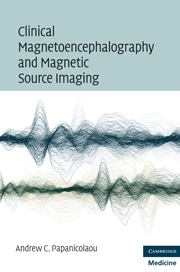Book contents
- Frontmatter
- Contents
- Contributors
- Preface
- Section 1 The method
- Section 2 Spontaneous brain activity
- 11 MEG recordings of spontaneous brain activity – general considerations
- 12 Normal spontaneous MEG – frequently encountered artifacts
- 13 Spontaneous MEG morphology
- 14 Abnormal spontaneous MEG
- 15 Contributions of MEG to the surgical management of epilepsy – general considerations
- 16 MEG investigations in lesional epilepsies
- 17 MEG investigations in nonlesional epilepsies
- 18 Pediatric nonlesional epilepsy surgery
- Section 3 Evoked magnetic fields
- Postscript: Future applications of clinical MEG
- References
- Index
18 - Pediatric nonlesional epilepsy surgery
from Section 2 - Spontaneous brain activity
Published online by Cambridge University Press: 01 March 2010
- Frontmatter
- Contents
- Contributors
- Preface
- Section 1 The method
- Section 2 Spontaneous brain activity
- 11 MEG recordings of spontaneous brain activity – general considerations
- 12 Normal spontaneous MEG – frequently encountered artifacts
- 13 Spontaneous MEG morphology
- 14 Abnormal spontaneous MEG
- 15 Contributions of MEG to the surgical management of epilepsy – general considerations
- 16 MEG investigations in lesional epilepsies
- 17 MEG investigations in nonlesional epilepsies
- 18 Pediatric nonlesional epilepsy surgery
- Section 3 Evoked magnetic fields
- Postscript: Future applications of clinical MEG
- References
- Index
Summary
Overview
Pediatric epilepsy surgery – and the candidates referred for evaluation of pediatric epilepsy – are distinctly different from adult epilepsy surgery and adult referral candidates. Additionally, the goals of epilepsy surgery in children may include objectives other than seizure freedom (e.g., developmental progression). A recent survey conducted by the Pediatric Epilepsy Surgery Subcommission of the International League Against Epilepsy (ILAE) revealed that the most common final operation was lobar and focal resection of the frontal and temporal lobes and that the majority of all children operated on had an apparent lesion on MRI. Identification of a focal lesion on MRI increases the chance of delineating a focal resectable epileptic network. Postsurgical seizure freedom is related to the resection of the correct epileptic zone. Studies in adults have found better postsurgical outcome for MRI-positive patients as opposed to MRI-negative patients. Though the currently available MRI may not identify a focal brain lesion, histopathological examination of the resected tissue often demonstrates the specific pathology. Hence the term “nonlesional” may be a misnomer.
However, in the ILAE survey a small group of children with no or subtle MRI findings (nonlesional MRI) did undergo epilepsy surgery. Few studies were available in the literature that evaluated postsurgical seizure freedom in children with intractable localization-related epilepsy and normal or nonspecific MRI findings. Case selection criteria and expertise of the epilepsy center determined the postsurgical outcome in such children.
No accurate estimate of the prevalence of normal MRI findings in children with intractable epilepsy who are potential surgical candidates is available. The majority of children with normal MRIs would seem not to be surgical candidates during presurgical evaluation.
- Type
- Chapter
- Information
- Clinical Magnetoencephalography and Magnetic Source Imaging , pp. 92 - 108Publisher: Cambridge University PressPrint publication year: 2009

